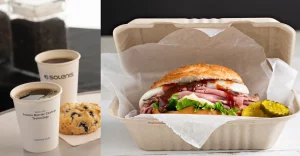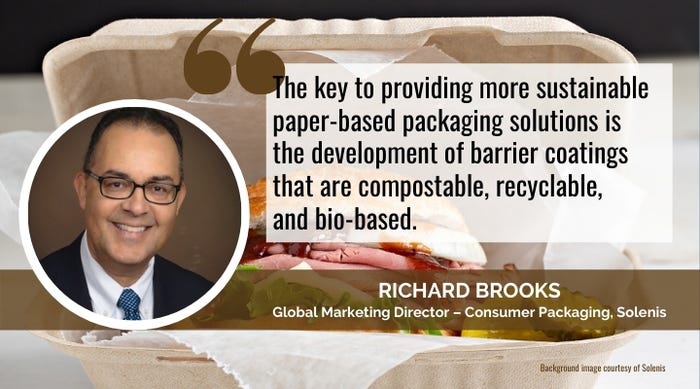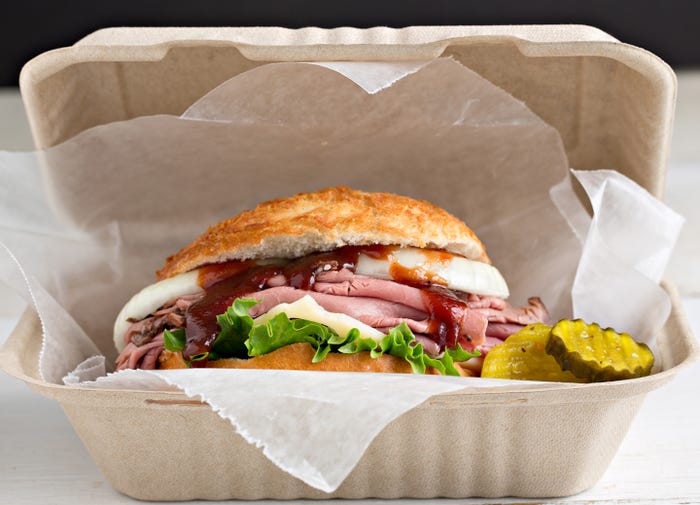Can Eco-Friendly Barrier Coatings for Paper Packaging Properly Protect Food?
More brands are opting for paper-based packaging these days because of its eco halo. But they might not fully understand the environmental, performance, and cost tradeoffs of the material’s barrier coating.

Most people can agree that chemicals of concern — like bisphenol-A (BPA) or per- and polyfluoroalkyl substances (PFAS) — have no place in food packaging, regardless of their barrier performance. Qualms about chemical migration from the packaging material to the ingestible food trump shelf life preservation.
Less worrisome alternatives are available, even some that tout being environmentally friendly. But can you get the same functional qualities? And is the alternative material safely recyclable, or repulpable in the case of paper packaging?
How do alternative chemical formulations affect the sustainability and performance of paper packaging?
Additionally, as more companies look at molded fiber containers and other types of sustainable paper packaging, understanding basics about the formulations that go into the paper and how it can help brand owners achieve their sustainability goals will become more important.
Addressing these questions is Richard Brooks, global marketing director for consumer packaging at Solenis. The company produces a range of TopScreen barrier coatings and Contour PFAS-free technology. Brooks joined the company in 2017, after a 35-year career at DuPont and Sonoco.
Amid the recent anti-plastics backlash, many brands are switching or looking at paper-based packaging because of its perceived positive environmental message to consumers. What’s your take on this and why?
Brooks: We are seeing many examples of major brand owners striving for more sustainable packaging solutions, either individually or via a consortium approach. This is both as a direct response to their customers, the consumers, or, in some cases, to get ahead of pending legislation. Paper-based packaging as an alternative to plastic packaging is one route that is being considered because, as stated, paper is generally perceived to be more recyclable and compostable, and therefore better for the environment.
However, this switch is harder than it looks. Plastic packaging inherently provides good functionality (such as barriers to water, moisture, and grease) at a low cost.
In addition, investment in equipment and plants for manufacturing plastic packaging are well established. Switching from plastic packaging to paper-based packaging requires innovation in materials and investment in equipment to ensure the required functionality and cost points are achieved. In some cases, new value chains will need to be established to ensure the proper scale.
Overall, we expect brand owners to selectively move toward more paper-based packaging over time by switching to readily viable solutions first.
The packaging industry has been working for years and years on reducing/removing chemicals of concern from their materials. Why is this so hard to do?
Brooks: As stated before, it is primarily due to functionality and cost. Inevitably, alternatives to these “chemicals of concern” require trade-offs on functional performance.
For example, per- and polyfluoroalkyl substances (PFAS) have been typically used in food packaging to provide oil and grease resistance, and they perform well under a wide set of conditions, from cold salad bowls to microwavable and oven-safe trays.
Alternative technologies, such as Solenis Contour PFAS-free oil and grease resistant barrier technology, perform under a narrower set of conditions, and therefore brand owners must be more selective as to where it can be applied.
Polyethylene (PE) and paraffin wax are commonly used as barrier materials that are laminated to paper to provide barriers to water and moisture. This laminated paper-based package is typically difficult to recycle and not compostable, and therefore not desirable from an environmental standpoint.
The best example of this is the single-use paper cup that consumers get on a daily basis at their favorite coffee shop. Alternatives, such as Solenis TopScreen barrier coatings, have been developed to replace PE as a more environmentally friendly solution that can be more easily recycled. However, these products are more expensive on a cost per article basis, so brand owners must decide on how much of a premium they and their customers will be willing to pay for a more sustainable solution.
Finally, once viable solutions have been identified and qualified, brand owners must work with the value chain to install enough capacity to meet the demand, since alternative solutions are not typically a drop-in for the materials that are being replaced.

What types of solutions/options currently exist, and how do they add up from a performance and sustainability point of view?
Brooks: There is a considerable amount of innovative work underway in the paper packaging industry to develop alternative solutions for plastic packaging. The industry sees this as a tremendous growth opportunity that provides more sustainable solutions for the world.
The key to providing more sustainable paper-based packaging solutions is the development of barrier coatings that are compostable, recyclable, and bio-based. These barrier coatings provide the required water and moisture barriers, oil and grease resistance, and sealability that impart the desired functionality to the paper-based packaging.
At Solenis, for example, we have developed a range of barrier coatings. Many of these solutions are now fully commercial, while others are still in development and should be commercial soon.
Alternatives to bisphenol-A (BPA), another chemical of concern that appears in some plastic packaging, have taken some heat themselves from a safety point of view. What are packaging suppliers of alternatives to per- and polyfluoroalkyl substances (PFAS) doing to mitigate a similar safety situation?
Brooks: One of the most critical aspects of the development of alternatives to chemicals such as PFAS and for new barrier solutions overall is the importance of regulatory compliance. Our R&D teams work hand in hand with our regulatory group to ensure that, for our new solutions, regional compliance standards such as FDA and BfR (German Federal Institute for risk assessment) are met.
Our regulatory team also works closely with regional industry regulatory groups to understand how legislation is evolving, so that we are in position to be proactive about which substances can and cannot be used in our barrier chemistry.
Finally, as a supplier to the paper industry, our customers rely on Solenis’ certification of compliance for all our chemical solutions.

PFAS-free barrier coatings from Solenis for molded fiber foodservice packages provide oil and grease resistance.
As a paper package material, molded fiber has seen healthy growth in the last decade or more, with sustainability in mind. But we’re hearing that supply might be an issue. Any thoughts on this?
Brooks: We agree that the molded fiber industry is poised for extremely healthy growth in the years ahead.
Thermoformed molded fiber foodservice applications are now competitive with plastics in terms of cost, performance, and aesthetics.
In addition, regional bans on EPS (expanded polystyrene) foam containers will lead to significant growth for competing molded fiber articles.
From a raw materials perspective, molded fiber is a relatively small segment of the paper packaging industry and will not limit supply.
Alternatives to PFAS that are used in molded fiber for grease resistance, such as Solenis Contour, are merging and will provide the desired recyclability and compostability for these products.
In the short term, the key concerns would be installed capacity and the time for new investment to be put in place. Still, our understanding is that molded fiber manufacturers and also some plastic manufacturers are actively investing in new equipment to ensure that supply capability will be in place to meet the anticipated demand.










